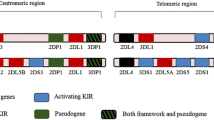Abstract
Natural killer (NK) cells are the most abundant lymphocyte population in the decidua. These cells express killer immunoglobulin-like receptors (KIRs), which upon recognition of HLA class I molecules on trophoblasts may either stimulate NK cells (activating KIRs) or inhibit them (inhibitory KIRs) to produce soluble factors necessary for the maintenance of pregnancy.KIR genes exhibit extensive haplotype polymorphism; individuals differ in both the number and kind (activating vs. inhibitory) ofKIR genes. This polymorphism affects NK cell reactivity and susceptibility to diseases, including gynecological disorders. Therefore weKIR-genotyped 149 spontaneously aborting women and 117 control multiparae (at least 2 healthy-born children). Several genotypes (i.e. combinations of variousKIR genes) were differently distributed among the patients and control subjects. Differences were observed in the numbers and the ratios of activating to inhibitory KIRs between patients and healthy women: (i) genotypes containing 6 activatingKIR genes were less frequent and those containing 6 inhibitoryKIR genes were more frequent in patients than in control subjects, and (ii) an excess of inhibitory KIRs (activating-to-inhibitoryKIR gene ratios of 0.33 to 0.83) was associated with miscarriage, whereas ratios close to equilibrium (0.86–1.25) seemed to be protective. In addition, the results suggest for the first time that sporadic and recurrent spontaneous abortions as well as miscarriage in the presence or absence of autoantibodies may have differentKIR genotypic backgrounds.
Similar content being viewed by others
References
Croy BA, van den Heuvel MJ, Borzychowski AM, Tayade C, 2006. Uterine natural killer cells: a specialized differentiation regulated by ovarian hormones. Immunol Rev 214: 161–185.
Hanna J, Goldman-Wohl D, Hamani Y, Avraham I, Greenfield C, Natanson-Yaron S, et al. 2006. Decidual NK cells regulate key developmental processes at the human fetal-maternal interface. Nat Med 12: 1065–1074.
Hiby SE, Regan L, Lo W, Farrell L, Carrington M, Moffett A, 2008. Association of maternal killer-cell immunoglobulin-like receptors and parental HLA-C genotypes with recurrent miscarriage. Hum Reprod 23: 972–976.
Hiby SE, Walker JJ, O’Shaughnessy KM, Redman CWG, Carrington M, Trowsdale J, et al. 2004. Combinations of maternal KIR and fetal HLA-C genes influence the risk of preeclampsia and reproductive success. J Exp Med 200: 957–965.
Kitawaki J, Xu B, Ishihara H, Fukui M, Hasegawa G, Nakamura N, et al. 2007. Association of killer cell immunoglobulin-like receptor genotypes with susceptibility to endometriosis. Am J Reprod Immunol 58: 481–486.
Koopman LA, Kopcow HD, Rybalov B, Boyson JE, Orange JS, Schatz F, et al. 2003. Human decidual natural killer cells are a unique NK cell subset with immunomodulatory potential. J Exp Med 198: 1201–1212.
Parham P, 2005. MHC class I molecules and KIRs in human history, health and survival. Nature Rev Immunol 5: 201–214.
Parham P, 2004. NK cells and trophoblasts: partners in pregnancy. J Exp Med 200: 951–955.
Rajalingam R, 2007. Killer cell immunoglobulin-like receptors influence the innate and adaptive immune responses. Iran J Immunol 4: 61–78.
Saito S, Nakashima A, Myojo-Higuma S, Shiozaki A, 2008. The balance between cytotoxic NK cells and regulatory NK cells in human pregnancy. J Reprod Immunol 77: 14–22.
Santoni A, Zingoni A, Carboni C, Gismondi A, 2007. Natural killer (NK) cells from killers to regulators: Distinct features between peripheral blood and decidual NK cells. Am J Reprod Immunol 58: 280–288.
Sun JY, Gaidulis L, Miller MM, et al. 2004. Development of a multiplex PCR-SSP method for killer-cell immunoglobulin-like receptor genotyping. Tissue Antigens 64: 462–468.
Trundley A, Moffett A, 2004. Human uterine leukocytes and pregnancy. Tissue Antigens 63: 1–12.
Varla-Leftherioti M, Spyropoulou-Vlachou M, Keramitsoglou T, Papadimitropoulos M, Tsekoura C, Graphou O, et al. 2005. Lack of the appropriate natural killer cell inhibitory receptors in women with spontaneous abortion. Hum Immunol 66: 65–71.
Wilczyński JR, 2006. Immunological analogy between allograft rejection, recurrent abortion and pre-eclampsia — the same basic mechanism? Hum Immunol 67: 492–511.
Witt CS, Goodridge J, Gerbase-DeLima MG, Daher S, Christiansen FT, 2004. Maternal KIR repertoire is not associated with recurrent spontaneous abortion. Hum Reprod 19: 2653–2657.
Author information
Authors and Affiliations
Corresponding author
Rights and permissions
About this article
Cite this article
Nowak, I., Malinowski, A., Tchórzewski, H. et al. Frequencies of killer immunoglobulin-like receptor genotypes influence susceptibility to spontaneous abortion. J Appl Genet 50, 391–398 (2009). https://doi.org/10.1007/BF03195699
Received:
Accepted:
Issue Date:
DOI: https://doi.org/10.1007/BF03195699




